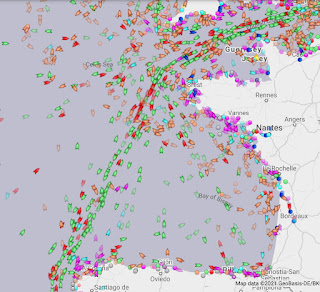Hi everyone,
Here is the summary of our passage from Falmouth in the UK to A Coruna in Spain. It was an easy passage thanks to light easterly winds.
Our strategy was to avoid the traffic concentration in the Channel and off the French coast. We therefore headed SW from Falmouth until abeam Brest and west of the Ushant-Finistere traffic lane. From there we tracked south, crossing the busy lane about half way between Ushant and Finistere. This worked well. Here's a snapshot of the traffic from MarineTraffic...
Here is our track…
The 'zig' was where an oil rig under tow, with multiple high speed cargo vessels passing it, 'bounced' us away from the traffic lane.
Here are the vital stats for the passage…
• Distances/Speeds
• Route Distance = 440nm
• Logged Distance = 416nm (yes, the log is indeed under-reading still)
• GPS Distance = 461nm
• Duration = 4 days 12 hours
• Average speed over ground = 4.3 kt
• Average day's run = ~90nm
• Best day's run = 118nm
• Minimum boat speed = 2 kt
• Maximum boat speed = 6.4 kt
• Weather
• Minimum wind speed = 2 kt
• Average wind speed = 10 knots
• Maximum wind speed = 15 with gusts to 22
• Apparent wind angle range = 40 to 120
• Seas up to 1m
• Swell up to 2m (which didn't help with sailing in light air!)
• Overcast for first 2 days, then gradually clearing to cloudless skies
• Engine
• Total = 28 hours
• Driving = 26 hours
• Charging = 2 hours
• Failures
• Nil
• Stars
• The boat!
• WindPilot vane gear (steered well when apparent wind over 10 knots despite our small air vane)
• Icom HF/SSB radio with SSB Minder running as our watch change alarm
• PredictWind Offshore app (over Iridium GO!) for obtaining GRIBs and routing recommendations
The motoring hours aligned with PredictWind's routing projection. Despite our lack of light-air sails and our first-reef sized cruising main the boat handled the light air really well. We sailed unless boat speed (corrected) fell below 3 knots, which was usually when apparent wind fell below 8 knots.
Overall the ECMWF, SPIRE and UKMO GRIBs from PredictWind were quite accurate. In light airs we found there was often a little more than predicted. We downloaded new GRIBs every 12 hours.
Our SignalK system records all onboard instrument data. We can graph data at any time. Here are some summary graphs...
 |
| Pitch and Roll Attitudes |
The Water Depth graph clearly shows where we were 'off soundings'. Another advantage of our route was to maximise off-soundings time to reduce the risk of fouling pots.
This is probably our first multi-day passage in which we didn't reef the main. We did put 3 furls (to about 50% LP) in the yankee at times.
As expected the weather improved as the passage progressed. The initial cold and overcast skies gradually became cool and clear skies. We had occasional drizzle throughout the passage. In A Coruna itself the weather is mild and very pleasant in the sun.
Last night we didn't need our thermals! That's 'mission accomplished'.






Nice reading and congrats for the passage!
ReplyDeleteWonder how do you record Wind Gusts. Both Wind Speed and Gusts seems to be the same data.
Hi Taku, Our Airmar 220WX provides both average and gust wind measurements each second. They're translated into SignalK format and then written to a database. The plotting is done using Grafana, which actually averages both those data sets, so the plotted gust value isn't the peak gust.
Delete